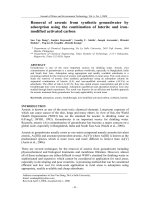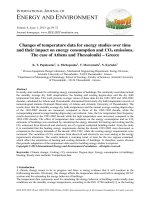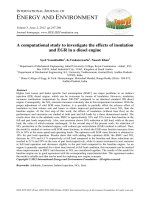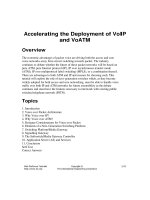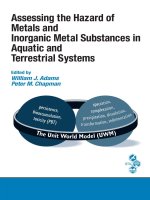- Trang chủ >>
- Khoa Học Tự Nhiên >>
- Vật lý
the restless universe understanding x-ray astronomy in the age of chandra and newton oct 2002
Bạn đang xem bản rút gọn của tài liệu. Xem và tải ngay bản đầy đủ của tài liệu tại đây (4.6 MB, 229 trang )
The Restless Universe:
Understanding X-ray
Astronomy in the Age of
Chandra and Newton
Eric M. Schlegel
OXFORD UNIVERSITY PRESS
The Restless Universe
This page intentionally left blank
THE RESTLESS UNIVERSE
Understanding X-ray Astronomy in the
Age of Chandra and Newton
Eric M. Schlegel
Oxford New York
Auckland Bangkok Buenos Aires Cape Town Chennai
Dar es Salaam Delhi Hong Kong Istanbul Karachi Kolkata
Kuala Lumpur Madrid Melbourne Mexico City Mumbai Nairobi
São Paulo Shanghai Singapore Taipei Tokyo Toronto
and an associated company in Berlin
Copyright © by Eric M. Schlegel
Published by Oxford University Press, Inc.
Madison Avenue, New York, New York
www.oup.com
Oxford is a registered trademark of Oxford University Press
All rights reserved. No part of this publication
may be reproduced, stored in a retrieval system, or transmitted,
in any form or by any means, electronic, mechanical,
photocopying, recording, or otherwise, without the prior
permission of Oxford University Press.
Library of Congress Cataloging-in-Publication Data
is available
ISBN ---
Printed in the United States of America
on acid-free paper
To the memory of my father, William H. Schlegel (–),
for much-needed advice at an unexpected time;
my mother, Jane S. Schlegel, for continually asking,
“When will I see your name in the paper?” to which I answer,
“Will this book do instead?”; and my wife, Lisa M. Schlegel,
for all her support and encouragement.
This page intentionally left blank
Preface
Overview
. “By three methods we may learn wisdom . . .”
(in which the Reader meets three X-ray satellites)
. “. . . and know the place for the first time.”
(in which the Reader learns how to locate celestial sources of X rays)
. “. . . every solution serves only to sharpen the problem, to show us
more clearly what we are up against . . .”
(in which the Reader sharpens those locations)
. “Sometimes you get shown the light in the strangest of places
if you look at it right.”
(in which the Reader learns about brightness and luminosity)
. Veritatem dies apertit. (Time discovers the truth.)
(in which the Reader sees the importance of arrival times)
. “. . . a spectrum is worth a thousand pictures.”
(in which the Reader encounters spectroscopy)
. “We’re all nothing but unified arrangements of atoms . . .”
(in which the Reader learns how spectroscopy connects to atoms)
. “If you have an important point to make, don’t try to be subtle
or clever. Use a pile driver . . .”
(in which the Reader receives a summary of X-ray astronomy)
. “Destiny is no matter of chance. It is a matter of choice . . .”
(in which the Reader learns about costs and choices)
. “I like the dreams of the future better than the history of the past.”
(in which the Reader gets a glimpse of future satellites)
Notes
Bibliography
Suggested Readings
Index
CONTENTS
This page intentionally left blank
Preface
cientists exploring the field of X-ray astronomy are in the midst of a time that
will not come again; we enjoy the excitement of what is often called an age of
discovery.
1
Dr. Carl Sagan said that there is only one generation that gets to see
things for the first time (in his case, the surfaces of the planets). This is a unique
time because prior generations knew little about X rays, and subsequent genera-
tions will view today’s amazing discoveries as history and as stepping-stones for
yet greater discoveries.
Science advances in phases, starting from pure discovery, or “un-covery,” and
ending with a mature field in which most of the questions have been answered
and little additional progress is possible. These advances do not parade steadily
forward in time. Consider, instead, the approach fans of jigsaw puzzles follow.
Assemblers first locate straight-edged pieces to build the frame. With the frame in
place, they see the range of colors and note potentially easy areas on which to
focus attention. They sift through the box, searching for those pieces first. When
the easy areas are done, the task shifts to filling in details, all the blue sky pieces,
for example.
In , a relatively slim astronomy book contained essentially all of our knowl-
edge of the planets in our solar system. By , however, the discovery phase of
planetary astronomy described by Sagan had essentially ended. We peered at the
surface of Mars from three landers (Vikings and and Pathfinder), gazed upon
the unique surfaces of the Galilean satellites (Io, Europa, Ganymede, and Callisto)
of Jupiter, imaged the rings of Saturn and the outer planets Uranus and Neptune
with their moons, rings, and atmospheric spots, discovered a moon of Pluto, and
flew a satellite through the tail of a comet. Images of all the planets save one (Pluto)
existed and could be bought in poster shops. Complete books for each planet had
been written, summarizing the missions of the s and s. Arguably, those
who paid attention to the planetary missions from the late s to the late s
or early s form the generation to which Sagan referred.
In X-ray astronomy, the period of our “first look” started with the Einstein
Observatory (-) and will end sometime in the next to years. Einstein
provided the very first images and spectra of the X-ray universe, but for a small
number of objects. By the time the Chandra and Newton missions end, we will
S
The Restless Universe
have a robust inventory. Future generations of X-ray observatories will likely be
designed for specific experiments or observational goals instead of functioning as
generic observatories.
This book sends the reader on a journey, one that encompasses the entire uni-
verse. Instead of a path that leads from Earth outward, this book explores a differ-
ent route by describing our view of the universe if we study the X rays that arrive
from astrophysical objects.
Several approaches exist for a book such as this one. I could present the results
of the discoveries of the past to years. I could take readers through the his-
tory of X-ray astronomy or focus on how the increasingly sophisticated instru-
ments have allowed detailed explorations of the X-ray universe. I chose to present
threads from each of these approaches; I hope I have woven a decent cloth. I do
not present everything that has occurred in X-ray astronomy during the past three
decades, because the resulting book would be used only as a doorstop. I also do
not present each and every “gee whiz” discovery, because many would be obsolete
by the time this book appears in print. Instead, I aim to provide a foundation for
further learning. The threads include the history of X-ray astronomy; the hard-
ware used to detect X rays; the satellites, past, present, and future, that have been
flown to collect the data; how we interpret the data; and most particularly, the
science we have learned, as well as speculations about what we will learn. I have
also not attempted to place every up-to-the-minute result here, particularly since
some of the most interesting science will be a complete surprise.
2
I have benefited from countless conversations, about X-ray astronomy and its dis-
coveries, with colleagues at science meetings and at the two places I’ve worked
during the past ten years (the NASA-Goddard Space Flight Center and the
Smithsonian Astrophysical Observatory). These colleagues are too numerous for
me to identify individually; I thank all for lively discussions, whether they remem-
ber them or not. I also gained knowledge from many people connected with the
Chandra project. A project the size of Chandra requires many hundreds of people,
from administrative assistants to scientists, engineers, and project managers. Space
constraints preclude listing even a small fraction of these people. The list of insti-
tutions significantly involved in Chandra’s design and construction is itself long:
NASA’s Marshall Space Flight Center (Huntsville, Alabama); the Office of Space
Science at NASA headquarters (Washington, D.C.); the TRW Space and Electronic
Group (Redondo Beach, California); Raytheon Optical Systems, Inc. (Danbury,
Connecticut), now a division of Goodrich Corporation; Optical Coating Labora-
tory, Inc. (Santa Rosa, California); Eastman Kodak Company (Rochester, New
York); Pennsylvania State University (University Park, Pennsylvania); Space Re-
search Organization Netherlands (Utrecht, Netherlands); Max Planck Institute
(Garching, Germany); Massachusetts Institute of Technology and Smithsonian
Astrophysical Observatory (Cambridge, Massachusetts), and Ball Aerospace and
Technologies Corporation (Boulder, Colorado).
I thank my agent, Jeanne Hanson, and my editor, Kirk Jensen, for seeing the
potential in an early draft of this book. Thanks to the copyeditor, Jane Taylor, for
catching several recurrently missed mistakes, and to the production editor, Joellyn
Ausanka and the overall compositor, Anne Holmes, for turning a stack of manu-
script and illustration pages into a sharp-looking book. I hope the words live up
to their efforts; any errors that remain are mine.
I especially thank my wife, Lisa, for her love and encouragement on those days
when the universe seemed too amazing to be described by mere words.
Preface
This page intentionally left blank
Overview
Brevis esse laboro, obscurus fio.
(When I labor to be brief, I become obscure.)
—Horace
rays are light, light that is fundamentally no different from the optical light
that enters our eyes or the radio light that carries the signal from our favorite
radio stations to our cars.
1
All of these—X rays, visible light, radio light, and more—
may be described as waves, specifically electromagnetic waves,
2
first described by
the Scottish physicist James Clerk Maxwell (–) in the s. At that time,
X rays were unknown, not to be discovered for another years. As we shall see,
X rays give us a picture of the universe very different from the one available to our
eyes and our optical telescopes.
Anyone who has been to a dentist or to a doctor to repair a broken arm knows
what an X ray is. Unfortunately, the term X ray, so applied, refers to the piece of
film illuminated by X rays. Mention “X-ray astronomy” to people and too often
they think we send beams of X rays into space to obtain an “X ray” of an object.
Many of us who carry out research on X-ray energies quickly learn to indicate that
the X rays we study come from somewhere in the universe. That comment is usu-
ally accompanied by a motion of the arm that starts with it fully extended and
ends with it close to the body.
So what are X rays? That we cannot see them with our eyes is irrelevant. Each
of the major areas of scientific knowledge is hip-deep in examples of insight gained
by looking at things we cannot see. X rays bathe Earth each second, arriving from
everywhere in the universe. Long before anyone discovered them, X rays carried
their energetic message, and they will do so long after Earth has ceased to exist.
What we have learned in the past years about the X-ray universe is astounding.
The space missions that have been and gone, and those that still collect data, have
largely defined the straight-edged pieces of the puzzle. The view of the universe
given to us by X rays may turn out to be absolutely critical to our understanding.
X
The Restless Universe
Not only can our eyes not detect X rays, but the atmosphere of Earth blocks
X rays from even reaching the ground. If our atmosphere did not do so, life would
likely never have started on this planet. The atmosphere protects us from the cel-
lular damage that the absorption of X rays produces. We need telescopes and de-
tectors, sensitive to X-ray light and launched on satellites above Earth’s atmosphere,
to study the X-ray universe. The Chandra X-ray Observatory,
3
Newton, and Astro-
E, the three satellites discussed in chapter , are the latest in a series of observato-
ries to explore the X-ray universe, continuing the endeavor of the past years.
Chandra is the third of NASA’s “Great Observatories.” The first is the Hubble
Space Telescope,
4
the second is the Compton Gamma-ray Observatory.
5
The fourth
and final Great Observatory will be the Space Infrared Telescope Facility (SIRTF),
currently scheduled for launch in late . Each of these observatories has made,
or will make, fundamental contributions to our understanding of our universe.
The Compton Observatory for the first time made the discovery and observation
of sources emitting gamma rays relatively easy. Data returned from the Hubble
Space Telescope clearly excite everyone who sees them. Few can look at the images
of the Eagle Nebula, for example, with its tall pillars of dark matter surrounded by
glowing, ionized gas, without wonder.
Chandra, as an observatory, is to X rays as the Hubble Space Telescope is to
visible light. The results from Chandra will continue to transform our under-
standing of our universe, if our experiences with Hubble are a guide.
The Restless Universe
This page intentionally left blank
C
“By three methods we may learn
wisdom . . .”
—Confucius
handra, Newton, and Astro-E: three satellites, all dedicated to the study of
X rays. Two and a half billion dollars spent. What is so important about
X rays from space? Why were three satellites built by three different space agencies
representing different countries? Astronomers designed and built only one satel-
lite to study the visible universe (the Hubble Space Telescope). What makes the
X-ray universe different? What are the differences among the three satellites? What
have we learned from previous X-ray missions? Why do X-ray images look so
different from those returned by the Hubble Space Telescope? Why was the loss of
Astro-E so devastating to X-ray astrophysics?
1
Will Chandra, Newton, or Astro-E
answer all of our questions about the X-ray universe?
2
What are X rays?
Launch: The Chandra X-ray Observatory
On July ,
3
at : A.M. eastern daylight time (EDT), the first launch attempt
of the space shuttle Columbia, carrying the Chandra X-ray Observatory, halted at
T–
4
seconds. A hydrogen sensor in the hazardous-gas-detection system surged to
parts per million (ppm) from a normal level of about ppm. Engineers had
designed the sensor to sample the air in the aft engine compartment every eight
seconds. At T– seconds, the sensor had reported its first high reading. An engineer
on the launch team waited for the next sample at T– seconds. When it reported the
second high reading, he manually executed a launch abort, stopping the countdown
about three seconds before main-engine ignition. Subsequent examination of the
data revealed a faulty sensor. The backup sensor, although less sensitive than the
primary one, never showed any increase in the gas level.
Forty-eight hours later, on July , after the investigation of the gas detection
sensors, after the replacement of the ignitors,
5
and after the refilling of the propel-
lants, the shuttle again stood bathed in spotlights. The second launch countdown
proceeded smoothly to the planned hold at T– minutes. All launches have built-in
The Restless Universe
holds, usually lasting minutes, that provide the team sufficient time to review
all the sensors and checklists to be certain that the shuttle, rockets, and crew are
ready to go. Toward the end of each hold, the launch director polls the team lead-
ers for a final “go” recommendation to lift the hold.
On July , the weather team reported the existence of a thunderstorm eight
miles from the launch site. The lightning protocol allows no lightning within
miles of the launch complex, or no lightning within miles plus at least min-
utes of elapsed time since the last detected stroke.
Flight controllers restarted the countdown clock at the end of the planned hold
with the understanding that another hold would occur at T– minutes until the
weather cleared. When the launch window opened at :
A.M., the thunderstorm
cell was still present. At : A.M., the launch director announced that an extra six
minutes had been added to the launch window, extending it to :
A.M. Just as the
launch team readied to resume the count after the T– hold, a lightning strike
occurred eight miles from the shuttle. The launch director immediately announced
the second launch abort.
On July , , at :
A.M. EDT, Columbia lifted off into clear skies (Fig.
.). Five seconds after liftoff, one of the electrical buses short-circuited, causing
a loss of two of the engine controllers. Each shuttle engine has two separate
controllers, so the liftoff proceeded.
Had the short occurred before engine
ignition, the launch director would
have aborted the launch. In addition,
had one more engine controller
short-circuited during takeoff, shuttle
commander Eileen Collins and pilot
Jeffrey Ashby would have been the
first crew to attempt to abort a take-
off and land the shuttle at the backup
landing site in Banjul, Gambia, on the
west coast of Africa.
Columbia reached an orbit seven
miles lower than had been calculated.
The flight team later traced the likely
cause of the lower orbit to a fuel leak
discovered in the aft engine compart-
ment.
6
The shuttle’s crew deployed the
Chandra Observatory seven hours af-
ter launch (Fig. .). During the sub-
sequent two weeks, ground controllers
gradually placed the observatory into
its final orbit and unfurled the solar-
Fig. 1.1. July 23, 1999, 12:31 A.M. eastern daylight time:
the launch of the space shuttle Columbia carrying the
Chandra X-ray Observatory. Eileen Collins commanded
the shuttle and the crew of four astronauts. (Image cour-
tesy of the public image launch archives at the NASA-
Kennedy Space Center.)
Chapter One
cell panels (Fig. .). Prior to the observatory becoming operational, all of the
parts used to construct Chandra had to first “outgas,” or lose the moisture accu-
mulated while in the atmosphere of Earth, to the vacuum of space. Outgassing is
necessary before any telescope is opened in space; a failure to outgas can cause the
accumulated moisture to freeze onto the telescope mirrors and detectors, consid-
erably reducing their effectiveness. Several weeks of additional work were neces-
sary before confirmation of Chandra’s status as an observatory, but it was finally
in orbit.
More than twenty years had elapsed from the time NASA received the first
proposal to build a high-resolution X-ray telescope. During that time, countless
design meetings, months of design reviews, years of work, and four launch slips
Fig. 1.2. The deployment of
Chandra occurred seven hours
after launch. Chandra is one of
the largest payloads ever carried
aloft by the shuttle. The image
appears distorted because a por-
tion of Chandra lies in shadow.
(Image courtesy of the public im-
age launch archives at the NASA-
Kennedy Space Center.)
Fig. 1.3. An artist’s sketch of Chandra in orbit with its solar panels deployed. The individual parts
of the satellite have been labeled. (Artist’s concept courtesy of TRW, Inc.)
The Restless Universe
had occurred. Thousands of people had contributed to placing the observatory
into orbit: project and program managers and their administrative assistants; bud-
get teams; mechanical, thermal, and electrical engineers; data aides and technical
assistants; members of test teams; and scientists.
Chandra’s first observation occurred just after the outer sunshade door, built
to protect the sensitive instruments from the overpowering light of the Sun, opened
on command on August , . The official “First Light” would take place after a
check that the mirrors and detectors were working correctly. The prime instru-
ment, ACIS (Advanced Charge-Coupled Device Imaging Spectrometer), imaged a
Fig. 1.4. The First Light image of the supernova remnant Cassiopeia A. On the left is the normal
view; on the right is a view with black and white inverted. The image is displayed inverted because
black on white offers higher contrast of the details; in addition, an excess of black ink sometimes
bleeds into the smaller, whiter areas during image production, particularly if image features are thin
and narrow. For both reasons, most astronomical images are displayed in the inverted manner, and
this book follows that convention. All figures include a scale bar somewhere in the figure, usually on
Chapter One
source lying just off the optical axis of the telescope. Chandra’s value lies in its
image quality, known as the point-spread function.
7
The size of the point-spread
function, when measured after the data were received in the Operations Center,
proved that Chandra focused X rays more sharply than had any previous X-ray
telescope. This measurement occurred even before attempts were made to sharpen
the focus or correct for any drift of the pointing direction.
The official First Light image, obtained on August , , is stunning (Fig.
.). Cassiopeia A (Cas A) is a supernova remnant, the grave marker of an ex-
ploded star.
8
The light from the explosion reached Earth in the year . The
the left, to indicate the size of the object. The scale is usually in minutes of arc (one minute of arc
equals 1/60th of a degree) but occasionally is much smaller. In the upper left corner of all figures are
the direction designations: the top of the figure is the north edge; east lies to the left. This orients the
object as an observer would see it in the sky. The small dot at the center of Cas A is the proposed
corpse of the star that blew up to form the remnant. (Image produced from data obtained from the
Chandra public data archive at the Smithsonian Astrophysical Observatory.)
The Restless Universe
distance to Cas A is estimated to be , light-years, so the star actually ex-
ploded about B.C.; the light traveled for , years before reaching Earth.
The X-ray image shows filaments of hot gas from the exploded star as well as a dot
of light at the center of the remnant. That dot is likely the actual carcass of the star,
and it had not been detected by any other telescope at any wavelength. So far as we
know, essentially two paths exist for a star that is about to explode. The path taken
depends on the mass of the star—the quantity of material contained in it. Astro-
physicists believe that lower-mass stars explode completely, leaving no stellar corpse
behind. For the higher-mass stars, however, the inner layers collapse to form a
neutron star or black hole; the collapse blows off the outer layers. Some of the hot
filaments in Cas A show evidence of oxygen, silicon, and iron. Combined with the
presence of a pointlike source as a candidate for the stellar corpse, Cas A is the
gravestone of a high-mass star. Investigations into the point source commenced
as soon as the First Light image appeared.
There’s more to learn from the First Light image. Examine the figure closely
and you will see a faint plateau of light that lies just outside the filaments. This is
the expanding shock wave. The explosion of a star not only disrupts the star itself,
but also creates a shock wave that expands outward. The expanding shock stirs the
gas that lies between the stars. Under the correct conditions, some of that stirred
gas will collapse and form new stars. By measuring the speed with which the shock
moves—for example, by obtaining a second image several years later and measur-
ing the increased diameter of the shock—we can obtain a better estimate of the
age of the remnant. For Cas A, the remnant’s age happens to be relatively well
known. For other remnants, however, that information could allow us to narrow
our search in the historical records for notes indicating the first appearance of the
supernova in our sky.
9
Launch: XMM-Newton
In contrast to the launch of Chandra, that of the European X-ray satellite, the X-ray
Multi-Mirror Mission (XMM), from Kourou in French Guiana, South America,
on December , , proceeded without a hitch (Fig. .). The rocket carrying
the satellite aloft was the Ariane , a new rocket for the European Space Agency
with heavy-lift capability. The launch, while flawless, was not without tension: the
test launch of the Ariane had exploded shortly after ignition of the main engines.
For the European Space Agency, the XMM launch was a triumph because XMM,
although a pure science satellite, represented its first commercial payload.
Controllers on the ground gradually raised XMM’s orbit so that, at its closest
approach to Earth, it was about , kilometers high; at the farthest point, it was
about , kilometers from the surface. By December , the solar panels were
deployed and several of its instruments had been powered up (Fig. .). Mission
Chapter One
controllers scheduled full activation of
the satellite to occur after the date rollover
from to just in case any Year
problems were uncovered. By mid-
February , all of the instruments had
been tested and the official First Light
images obtained. XMM was renamed to
honor Isaac Newton.
The European Space Agency released
the official First Light images to the press
on February , . The first data were
quite impressive. An image (Color Fig.
[see insert]) of one of our galaxy’s near-
est neighbors, the Large Magellanic
Cloud, shows the very active region of
Doradus, an area known for its abundant
births and deaths of stars.
10
The large cir-
cular arc near the center of the image is Doradus C, a supernova remnant. Near
the center of the arc is a faint point source. This point source, if it is confirmed to
lie at the distance of the Large Magellanic Cloud, is probably the corpse of the star
that exploded. The bright object east of Doradus C is the supernova remnant
Fig. 1.6. An artist’s sketch of Newton after it reached
its final orbit. (Image used courtesy of the European
Space Agency.)
Fig. 1.5. December 10, 1999: the launch of the European equivalent of Chandra: XMM-Newton.
This launch took place from the European launch complex in French Guiana and used the heavy-lift
capability of the new Ariane 5 rocket. (Image used courtesy of the European Space Agency.)
The Restless Universe
NB.
11
This object is similar to the Crab Nebula in our galaxy, the remnant of a
star that people observed exploding in A.D. . Another, better known, super-
nova remnant lives nearby: the remains of the supernova of . SNA was the
closest supernova in more than years. It is the bright spot southwest of
Doradus C. Finally, the faint point sources, particularly those to the southeast of
Doradus C, are probably background active galaxies shining through the Large
Magellanic Cloud.
12
Another image (Color Fig. [see insert]) shows a compact group of galaxies
known as Hickson Compact Group (HCG) , about million light-years away.
13
Seven galaxies make up the group. All the galaxies in the group show evidence of
mergers or collisions. Whether galaxies collide is not a contentious issue because
we know nearby galaxies show considerable evidence of past collisions. Collisions
among galaxies rob both victims of the gas and dust necessary to make new stars,
instead spraying the gas and dust away. Mergers replenish the gas and dust as the
nuclei of the colliding galaxies gradually sink into a single gravity well. A critical
question of current research in astrophysics is the degree of evolution of the struc-
tures in the universe. As we look ever deeper, we look ever further back in time. By
looking at the earliest galaxies and comparing them with nearby galaxies, astrono-
mers attempt to measure that evolution. The number of mergers and collisions is
one measurement.
The Newton image of HCG shows four of the primary galaxies in the group.
In the figure, blue designates all X rays with energies above three kilovolts (“hard”
X rays; a kilovolt is a unit of energy), while red signifies X rays with energies around
. kilovolts (“soft” X rays). The westernmost galaxy, NGC , shows a bluer color,
so it has a hard spectrum. Astronomers assign these colors in a consistent but
arbitrary manner as a quick method to compare objects in an image such as HCG
. Note that each of the galaxies shows a “core-halo” structure: the cores appear to
be brighter, perhaps indicating gas and dust fueling a central nucleus containing a
galactic black hole. The nuclei of galaxies such as those in HCG fall between
those of normal galaxies, which have inactive nuclei, and active galaxies, where
the nuclei have high luminosities.
Launch: Astro-E
The Japanese Space Agency, late in , scheduled the launch of the Japanese-
American mission Astro-E (Fig. .) for February , . The Japanese are noted
for scheduling a launch date and time a year or more in advance and sticking to
the schedule. They have done so on four previous occasions for their X-ray satel-
lites alone. For the Astro-E launch, high winds at the launch site delayed one launch
attempt. A second was called off moments before ignition because of a problem
with a tracking station.

